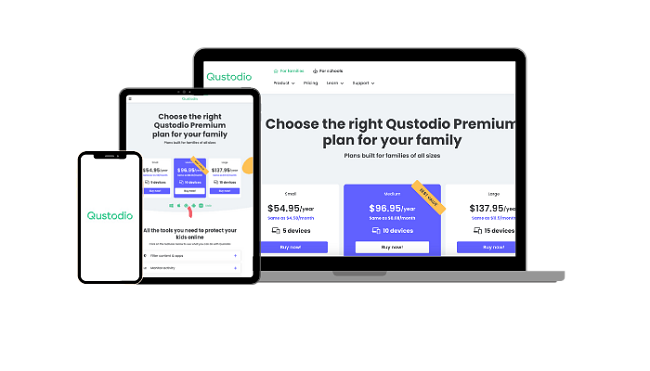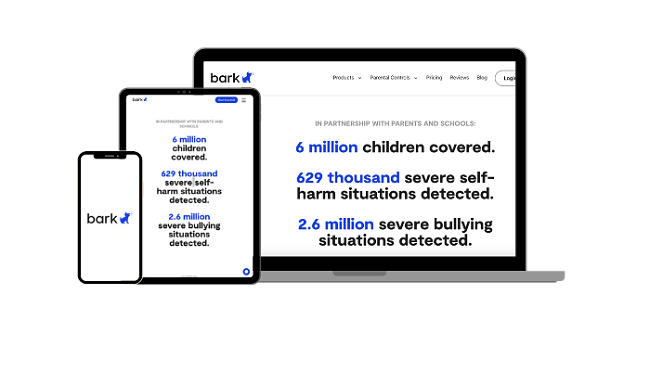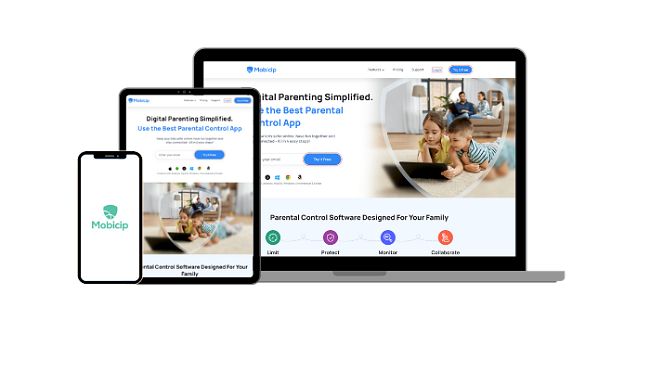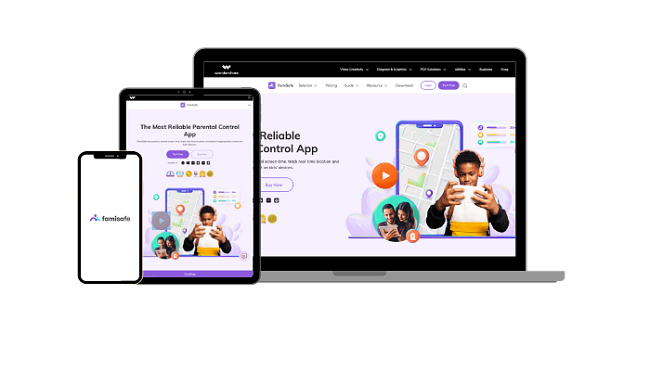5 Best Parental Control Software for Windows PC in 2024
Even though my kids spend most of their time on their smartphones, they still manage to find time to use our Windows laptop as well. In my quest to give them the freedom to use these devices, while still being a responsible parent, I tested over 50 premium parental control programs over the course of a few months. I was surprised at how many of them, even some of the “popular” ones, were not very good.
All the software choices listed operate smoothly on Windows, but the ones I recommend also provide outstanding mobile apps. From my perspective, I discover the multi-platform support to be especially advantageous because it allows me to utilize one application for monitoring all the devices utilized by my family.
During my tests, Qustodio performed very well and had the best overall score out of all the programs I tested. It has a strong web filter, flexible screen time management tools, and a parent dashboard that I could access from any device. Best of all, you can try Qustodio free for 30 days – no credit card needed! This will give you the opportunity to learn more about your kids’ habits and set limitations based on the insights you’ll get.
Monitor Your Kids Devices with Qustodio!
Quick Guide: Rundown of the Best Parental Control Programs for Windows in 2024
- Qustodio: Excellent web filter, time management tools, and you can access the dashboard from anywhere.
- Bark: The best social media monitoring tools, strong web filters, but no geofence feature.
- Mobicip: Reliable web filter and screen time tools, but social media monitoring only works with Facebook, Instagram, and Snapchat.
- Norton Family: Fully customizable web filter and screen time management tools, but no app based time restrictions.
- FamiSafe: Custom screen time tools, but dashboard is not very intuitive.
Top 5 Parental Control Programs for Windows
1. Qustodio: #1 Parental Control software for window with Excellent Web Filter and Screen Time Tools
Key Features
- Advanced time management tools
- Web filter has 30 categories
- YouTube monitoring
- Create unique profiles for each child
- Access parent dashboard from any device
- Try Qustodio free for 30 days – No credit card required!
The first thing that jumped out to me when testing Qustodio for Windows was that I was able to set up different user profiles for each kid, on one computer. This was important since my 16-year-old didn’t want to have the same web filter as the 7-year-old, and it would be impossible to enforce time limits if all the kids were grouped together.
Speaking of time limits, I was very happy with the flexibility of the screen time controls. I was able to set both a daily time limit and create a schedule that blocked the computer at specific times. Qustodio gives two options for what happens when the screen time is up:
- Lock Navigation: This disables the internet, but the computer is still functional. I liked this option, as it allowed my kids to use the computer for writing assignments on Word or PowerPoint, but kept them from getting distracted and going online instead.
- Lock Device: This option logs all users off the desktop. I found this to be a good option at bedtime.
The only issue I had with the schedule feature was that the schedule grid is broken up into hour-long segments, with no option to adjust it. So if, for example, I wanted the computer off from 6:00 – 6:30 for dinner — I wasn’t able to.
The web filter is fully customizable. It has 30 categories and gives the option to Allow, Block, or send me an Alert if the kids try to go to a site with that category. I tested the filter on Chrome, Firefox, and Edge and it worked very well.
The parent dashboard can be accessed from any device and makes it easy to set up the rules, time limits, and get details on what the kids are doing on the computer.
Qustodio has a 30-day free trial, with no credit card required, so you can try it yourself risk-free. At the end of the trial, I had the option of purchasing one of the subscription plans or using the limited free plan.
2. Bark: Strong Social Media Monitoring Tools and Screen Time Limits
Key Features
- Monitors 30+ of the most popular apps and social media platforms
- AI monitoring recognizes slang, emojis, and triggering keywords
- Plugins for Chrome and Microsoft Edge
- No limit on the number of connected devices
- Try Bark for free with the 7-day trial!
Bark is a bit different from the other parental control programs that I’ve tested. Its main focus is social media monitoring. It is compatible with over 30 of the leading social networks and will monitor the activities, chats, images, and posts on an account level. This means that it doesn’t really matter if the kids are chatting on the computer, phone, or tablet. Bark will be able to recognize what is going on, through smart AI keyword, emoji, and slang recognition.
I used the web filter to block access to specific websites and general website categories that I didn’t want my kids viewing. These included sites that write about, and have images, glorifying violence, drugs, and sex. The Screen Time management features allow me to choose a “bedtime” when the internet is blocked. The phone can still be used to make and receive calls, ut at least I know that my kids aren’t sitting in bed watching YouTube videos all night.
Bark has a really nice dashboard which I can log in from any device and see the reports and relevant information. Thanks to these reports, I found out that one of my kids was being cyberbullied on Snapchat and was able to help out before things got even worse.
Bark recently upgraded its Windows features to include a monitoring feature that works with most of the popular browsers. The software will monitor and create reports based on the website metadata, page titles, web searches, and some images and videos that are saved to the device.
Bark has two subscription options, Bark Jr. and Bark Sr. I got the Bark Sr. account which included all the premium features and has a free 7 day trial. This gave me plenty of time to connect Bark with my kid’s social media and email accounts, and see just how reliable the monitoring features were for PC.
3. Mobicip: Default Web Filter and Screen Time Limits Based on Child’s Age
- Monitor all online activity from a remote dashboard
- Category based web filter makes it easy to block inappropriate sites
- Monitor social media interactions
- Create a daily screen time schedule
- Try Mobicip free for 7 days
I found Mobicip for Windows to be an easy parental control tool to use. Once I downloaded and installed the app on the computer, I was able to create filters and monitor all online activity remotely.
The web filter is based on 18 different categories, and it’s on by default, with categories blocked based on the child’s age. I made some adjustments based on my son’s personality and browsing habits and then added specific URLs that I wanted to block, even though they would be allowed based on the category filter.
After a web filter, the next important task was to enforce screen time limits on the computer. Mobicip has a few tools for managing screen time. The first is a schedule of when the computer is available. Within each time, I can also customize the type of activity they can do on the computer. For example, I can create a time block for homework, where entertainment and social media sites are blocked, but educational sites are available. During school hours or at night, I can block the internet completely.
In addition to the usage calendar, I can set an overall time limit per day. Just because the computer is available for 7 hours a day doesn’t mean I want my child sitting at the computer the entire time. Lastly, if I need my son off the computer, I can always clock all devices, which restrict internet usage regardless of what the schedule of daily time usage says.
The one thing I found troubling is that during the installation, I got a message that I would need to uninstall Norton or Kaspersky antivirus, as the programs are not compatible with each other.
Mobicip has several subscription tiers, depending on how many devices you want to monitor and which features you need. The Basic plan is free but doesn’t give you access to the advanced screen time or filtering option. The Standard and Premium options allow for monitoring up to 20 different devices and complete control over the devices. You can activate the Mobicip 7-day free trial, without having to enter your credit card information, to test the features and see which plan is best for your family.
4. Norton Family: Safe Remote Learning Feature and 24/7 Location Tracking
Key Features
- Customizable web filter
- Remote Learning accessibility
- Forces safe search results for major search engines
- Unlimited child profiles
- 30-day money-back guarantee
Norton’s user-friendly interface is one of its greatest advantages. The software installation process is simple and setting up child accounts is hassle-free. Additionally, users can customize web filters and screen time limitations according to their preferences with ease.
Of course, none of this would matter if the software didn’t work the way it should, so I challenged my kids to beat the app. They tried to extend their screen time limits, access websites I blocked, and watch YouTube videos to see if I knew what they watched or how much time they spent on it. I was happy to see that they were unable to bypass the restrictions and that Norton Family includes a link for the kids to ask permission to access what they can’t, so you can open a dialogue about it.
With its web filter, Norton Family gives me complete control over when setting the web restrictions. Based on the text, metadata, and images on the website, Norton Family uses AI to place every website into at least one of 47 categories. I felt comfortable letting my kids use their phones to browse the web since I couldn’t find any weaknesses in the web filter.
But you don’t have to take my word for it. You can try out Norton Family free for 30 days. This will give you full access to all its features and unlimited account across multiple devices for your kids.
5. FamiSafe: Blocks Websites on all Browsers and Gets Real-Time Reports
- Blocks and set limits on Windows apps
- Monitors online activity in Private or Incognito Mode
- Try FamiSafe free for 3 days
FamiSafe offers a comprehensive web filter that is compatible with all major browsers. To test its effectiveness, I had my children attempt to bypass it using Incognito Mode. To my satisfaction, their efforts were unsuccessful, and the parental control tool diligently documented all the activities that took place in Incognito Mode.
The web filter has over 20 categories that cover nearly every type of website, and I was able to choose which to allow and which to restrict.
The FamiSafe screen times can use some improvement. There is a daily usage limit, which is nice, but the calendar is not very customizable. I can pick a time in the morning to unlock the device and a time at night to lock it, but nothing in between. However, it does include an Instant Block option, which is nice, but I would prefer something automatic.
One thing I do like about the screentime options is that I can set restrictions or completely block apps that were downloaded from any website or the Windows app store.
After installing the app on our Windows computer, I was able to manage the schedules and filters from the dashboard. It has a clean interface with a complete activity timeline, alerts, and requests section.
FamiSafe has three subscription options, each of which can protect up to 10 devices, and only differ in terms of length of the contract. Before committing to a plan, you can try FamiSafe free for 3 days and see how the parental control features work for your family.
How I Tested and Rated the Best Parental Control Programs for Windows
Over the course of several months, I purchased and tested over 50 parental control programs on my Windows 10 laptop and desktop. (but I made sure all the software I recommended here works well with Windows 8 and 7 as well, so you don’t have to worry about what version you are using). The rankings were mainly based on the following criteria:
- Time management tools: The parental control app must allow me to put screen time limits on the computer. It got bonus points if I could set up separate profiles for each kid.
- Web Filter: The parental control app needs a strong web filter that works on multiple web browsers. My kids were able to find ways to bypass many of the filters or they would get notifications that pages were being blocked, even though the content was acceptable. The programs on my list proved to be too strong for my kids to bypass and they used advanced technology to recognize the context of the content.
- Ease of use: The easier a program was to download, install, and set up, the higher rank it received.
- Customer Support: I examined the customer support departments of each software I utilized. Whenever Live Chat was available, I would pose inquiries to ascertain whether I was interacting with an actual individual or an automated bot. In cases where Live Chat was absent, I dispatched emails and initiated support tickets to gauge the timeliness and caliber of the responses. Additionally, I delved into the information repository and Frequently Asked Questions (FAQ) section of each company to locate resolutions for my queries. Without exception, I scrutinized the efficacy of the money-back guarantee to verify their commitment to honoring it and facilitating a refund.
How to Choose the Best Parental Control App for Windows in 2024
Choosing the best parental control app for Windows involves considering several factors to ensure that the app meets your specific needs and provides effective monitoring and management of your child’s online activities. Here’s a step-by-step guide to help you make an informed decision:
Define Your Needs and Goals
Start by identifying what you want to achieve with the parental control app. Are you primarily concerned about filtering content, setting screen time limits, monitoring social media, or a combination of these? Clarifying your goals will help you narrow down your options.
Compatibility and Device Support
Ensure that the parental control app is compatible with the Windows version you’re using. Additionally, check whether the app supports other devices your child might use, such as smartphones, tablets, or gaming consoles.
Content Filtering and Blocking
Look for apps that offer robust content filtering and blocking capabilities. The app should be able to block inappropriate websites, apps, and content categories based on your child’s age and maturity level.
Time Management and Screen Time Controls
A good parental control app should allow you to set screen time limits for different apps and activities. It’s also helpful if the app offers scheduling options for when devices can be used and when they need to be off-limits.
Remote Management and Notifications
Opt for an app that provides a user-friendly interface for parents to manage settings remotely. Notifications and reports about your child’s online activities should be easy to access and understand.
Trial Period
Many parental control apps offer a free trial period. Take advantage of this to test the app’s features and usability before committing to a subscription.
Customer Support
A reputable parental control app should have responsive customer support in case you encounter any issues or have questions.
Cost and Value
Consider the pricing structure of the app and whether it offers good value for the features it provides. Compare the features of different apps at similar price points.
Ease of Use
The app should be intuitive and easy to navigate, especially if you’re not tech-savvy.
Based on these factors, you can create a shortlist of parental control apps that align with your requirements. Qustodio, Bark, and Mobicip are all great options for Windows and you can try them yourself by taking advantage of their free trial options.
Top Brands That Didn’t Meet the Criteria
Not every brand succeeds in meeting industry benchmarks or consumer expectations. The reasons can range from lack of features to poor quality and many other factors. Here are the top brands that didn’t meet the criteria:
1. Windows Family Safety (now known as Microsoft Family Safety)
- Limited Filtering: Earlier versions were criticized for not providing detailed content filtering. This meant that some inappropriate content could still be accessed despite the controls in place.
- Complicated Setup: Some users found it confusing to set up and manage Family Safety, especially when compared to third-party tools.
- Limited Reporting: Detailed reports about user activity were sometimes lacking, making it hard for parents to get a complete understanding of their child’s online habits.
2. KidLogger
- Privacy Concerns: KidLogger not only tracks websites but also keystrokes, leading to concerns about privacy and potential misuse.
- Complex Interface: The interface was reported to be less intuitive for non-tech-savvy parents, making it harder to set up and monitor effectively.
- False Positives: The app sometimes flagged harmless activities as suspicious, which could lead to misunderstandings between parents and children.
3. Net Nanny
- False Positives: Net Nanny was sometimes overly aggressive with its filtering, leading it to block benign websites. This could become frustrating for users who constantly had to whitelist legitimate sites.
- Pricey: Compared to other parental control software, Net Nanny was often considered on the pricier side, especially for households with multiple devices.
- Difficult to Uninstall: Some users reported difficulties when trying to uninstall Net Nanny from their computers. A software solution that’s hard to remove can become a source of frustration.
FAQ
Are there free parental control programs for Windows?
What features should I look for when installing parental control apps on Windows?
Can I use the same parental control app to monitor my child’s phone and Windows computer?
Bottom Line
A good parental control program for Windows should be a requirement for all parents. It will give our kids the freedom to go online while protecting them from potential harm.
After extensive research and testing, Qustodio was the best program I tested for Windows, and it’s what I’ve continued to use on my home computer. You can take advantage of Qustodio’s free trial and use all of its premium features free for 30 days, which is great if you want to test the program out before you commit to it.












Leave a Comment
Cancel